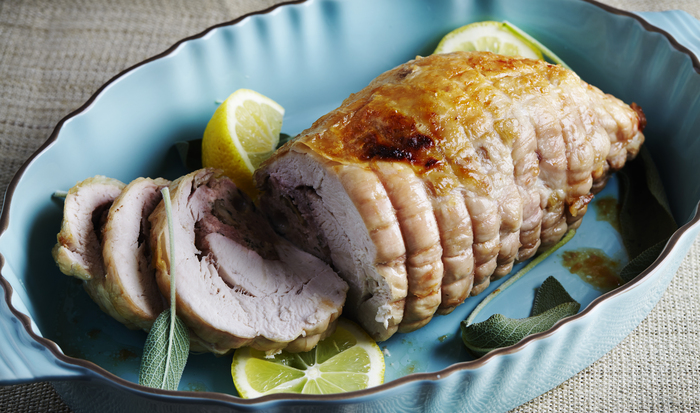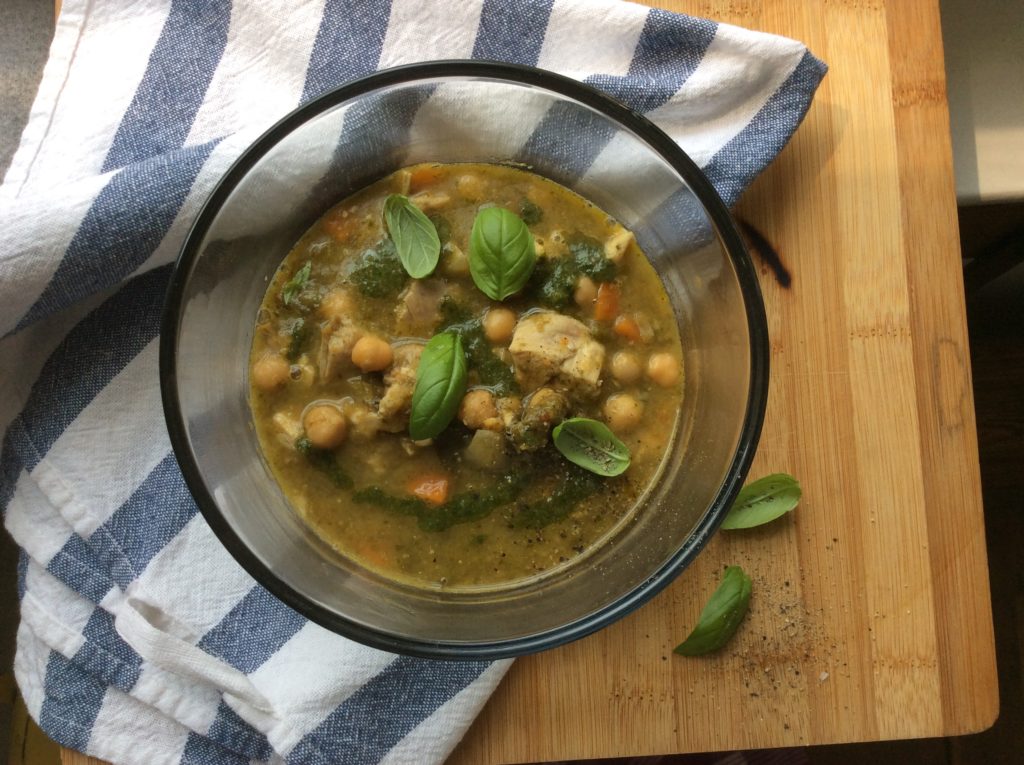Turkey


Turkey meat is a lean yet protein-dense poultry meat. Turkey meat can be found fresh or frozen, in whole-bird form or butchered into cuts like breasts and legs. Turkey has a rich flavor and is most commonly eaten at the Thanksgiving or Christmas holidays, though it can be enjoyed year-round. Turkey is packed with protein but low in fat: three ounces of white turkey meat contains over 24g of protein yet just 3.25g of fat. Purchase fresh meat from a trusted source (ideally a butcher or farmer), and as with other poultry, cook turkey until its internal temperature reaches at least 170°F for safety reasons.
A turkey is a large bird, native to the Americas, which are raised as poultry for their meat.
Most turkey meat available in North America is farmed; however, wild turkeys do exist and their meat is also edible and enjoyable (though it tends to have a stronger, gamier flavor).
In the US and Canada, Turkeys are traditionally eaten at Thanksgiving and/or Christmastime – on these occasions it is common to roast the full bird (minus its head and extremities).
But turkey is not just for holidays: fresh or frozen turkey meat is available year-round. The cuts are similar to chicken, (for example, as breasts and thighs) although the sizes are much larger.
Turkey is commonly found as “deli meat” or “luncheon meat” – pre-cooked, seasoned and sliced meat preparations usually added to sandwiches. (Other variations may include turkey sausage or turkey bacon.) However, keep in mind these are heavily processed versions of the meat, usually with preservatives, salt, and other seasonings. It is not turkey in its true form.
Turkey can be compared to chicken but its flavor, though relatively mild, is more distinctive – it has a rich, slightly gamy, savory taste yet is not overbearing and can respond well to bold seasonings. Because it is a lean yet protein-dense meat, turkey is sometimes used as a replacement for fattier meats.
As with chicken, turkeys offer both ‘white’ and ‘dark’ meat. White meat refers to the leaner cuts such as breast, which maintain a pale beige color even when cooked. Dark meat refers to slightly fattier and richer cuts such as leg or thigh, which take on a darker color once cooked.
Whole, roasted turkeys are generally considered a beautiful thing if cooked properly: the turkey’s outer skin takes on a burnished, golden hue and crispy texture.
The large, grand nature of a whole roasted turkey is valued for its visual appeal, helping to secure its time-honored place at the holiday dinner table.
Three ounces of roasted turkey meat (white meat, without the skin) contains about 135 calories, 24.7 grams of protein, and 3.26 grams of fat.
In addition to being a lean yet protein-packed meat, turkey is high in iron, zinc, potassium and B vitamins.
Note: There is a popular myth that says turkey makes you sleepy. While turkey does contain Tryptophan (a component that gets converted into melatonin, the sleep-inducing hormone), it doesn’t actually contain more than many other foods. The post-Thanksgiving meal daze that many people experience is more likely due to an abundance of carbohydrates, alcohol consumption, and overeating (or a combination of all three).
Throughout the year a limited selection of fresh turkey cuts are usually available in the poultry section of your grocery store. Choose the freshest cuts possible – avoid meat that looks grey or dull. Look for the date the meat was butchered – it should be as close to the date of purchase as possible. At the very least, the current date should be several days away from the expiry date.
It’s best to purchase meat from a trusted source. Review the details on the package that tell you about the farm and the meat itself. But keep in mind that sometimes marketing ‘buzz words’ can be misleading. Therefore, if you have questions or concerns about where your meat comes from and want to know about the farm and/or farming methods, it’s best to buy your meat from a local butcher or at the farmers’ market.
If choosing a whole turkey you’ll first have to decide if you want fresh or frozen. This is largely a matter of personal choice. Many supermarkets offer both fresh and frozen options during the winter holidays.
The ideal way to acquire a fresh turkey is to speak with your local butcher ahead of time. A good butcher can inform where and how the turkey has been raised. He or she may even be able to acquire an heirloom variety of turkey, provide you with organic or small-farm options, or at least assure you of the turkey’s quality. While this can require a bit more time (and possibly money), it does significantly increase your chances of a tastier and more nutritious turkey.
Keep your turkey in the fridge or freezer depending on when you plan to use it. If you keep it in the fridge, be sure to use it before the expiry date. Remember that frozen meat, once defrosted, cannot be refrozen.
If buying from your butcher, you can ask him/her how long the meat will keep in the fridge. However, it’s best to cook and enjoy the meat as soon as possible – the fresher it is, the better it will taste. Generally, fresh meat should only be purchased a day or two before you plan to cook it.
Turkey meat, once cooked, can be kept in a sealed container in your fridge for about five days.
Roasting a whole turkey
Roasting a whole turkey is a significant undertaking. Many families have their own traditions in this regard. In general, the basic process is as follows:
Cooking cuts of turkey
Cooking individual cuts of turkey is much simpler: you can prepare the meat in a similar fashion to chicken or pork, though you will likely have to allow for longer cooking time.
For example, to bake a turkey breast, preheat oven to 350°F. Season breast with salt, pepper, any other spices of your choosing, and a tsp of olive oil. Place on a baking sheet or shallow roasting pan and bake for one hour. Flip the breast over and bake for another half hour, or until the thickest part of the meat registers 165°F on a meat thermometer.
Ground turkey can be used as an alternative for other types of ground meat: turkey chili, turkey meatballs, turkey meatloaf are alternatives you may enjoy.
Safety
Like other forms of poultry, turkey meat should be cooked through. The USDA recommends cooking turkey meat to at least 165°F.
That said, keep in mind that turkey is a lean meat – especially the white meat. Avoid overcooking it or it may taste dry.
As with all meat, wash your hands carefully after touching raw meat and clean up thoroughly when you are done.
If raw poultry meat ever smells sour, stinky or sulfur-like, toss it – it’s no longer safe to eat.
Using turkey leftovers and ‘strange bits’
It would be remiss to discuss turkey preparations without addressing one of its most common forms: leftovers. Because turkeys are large birds, traditionally roasted for holiday feasts, there is often meat left over after the main meal.
Turkey sandwiches and turkey soup are common uses, but feel free to get creative. For example:
Turkey meat can be kept in the freezer for later uses. Store it in a heavy, sealed plastic bag for up to three months.
Note: If you buy a whole bird, sometimes the turkey neck, gizzard, and giblets (organ meat) come with it, either stuffed into the bird or provided separately. Don’t throw away these valuable parts of the bird: they can be quite tasty and the giblets are a good source of B vitamins, iron, and protein.
The giblets can make an excellent, rich gravy to accompany your bird. The neck and gizzard can be wrapped in foil, roasted along with the turkey and enjoyed. And after the main meal is eaten, the turkey carcass can be used to make a tasty, nutritious bone broth (stock) or soup.

Just in time for fall, this hearty and nourishing soup is perfect for lunch or dinner. Make it in advance and it'll be a fast, tasty meal option throughout the week. Serve with a green salad or some grilled flatbread.
Prep Time: 20 minutes Cook Time: 30 minutes Yield: 3 litres
Stock:
In a large, heavy bottomed stockpot set to medium-high heat, add the olive oil and brown the turkey wings, onion, and carrots until golden brown, about 10 minutes.
Add the celery, bay leaf, thyme, and peppercorns and cook another 2 minutes.
Add the water and bring up to a simmer. Skim off the foam and fat that rises to the surface using a ladle or large spoon.
Lower the heat to medium and cook, partially covered, for 2 hours. Continue to skim the surface every 15 minutes or so. Strain the stock, and separate the meat from the wings. Set the meat and the stock aside separately and discard the bones and vegetables.
Soup and Pesto:
In a large , heavy bottomed stockpot set to medium-high heat, add the olive oil and brown the carrots, onions, celery, garlic, chilli flakes, and bay leaf, about 5 minutes.
Add the escarole, 1 tsp of salt, and white wine and cook for 2 minutes, letting the wine evaporate a bit.
Add the turkey stock and chickpeas, and bring up to a boil. Cook for 30 minutes on medium heat.
While the soup is cooking, prepare the pesto.
Pulse the basil, walnuts, olive oil, and 1/4 tsp salt in a blender until just incorporated but still chunky. Pour into a bowl and set aside.
Once the soup has cooked for 30 minutes, add 1 litre of the soup to the blender (no need to clean the blender between the pesto and this). The best way to blend the soup is to keep the lid partially open so that the heat can escape. Try covering the top with an old kitchen towel, folded over a few times. Be sure to hold the lid lightly as you blend.
Pour the blended soup back into the pot with the soup base and add the cooked turkey meat. Stir well, and keep skimming any fat or foam. Cook for another 20 minutes, and season with the remaining 1/2 teaspoon of salt if necessary.
Garnish the soup with a hearty drizzle of the pesto and serve.
Store leftovers in fridge.
Enjoy!
Precision Nutrition’s Encyclopedia of Food expands every single month as we highlight new foods and showcase beautiful food photography. If you’d like to stay up to date, simply click this link. From there, we’ll send you a FREE copy of our recipe book. We’ll also let you know when new and delicious foods are added to the site.
Turkey meat is a lean yet protein-dense poultry meat. Turkey meat can be found fresh or frozen, in whole-bird form or butchered into cuts like breasts and legs. Turkey has a rich flavor and is most commonly eaten at the Thanksgiving or Christmas holidays, though it can be enjoyed year-round. Turkey is packed with protein but low in fat: three ounces of white turkey meat contains over 24g of protein yet just 3.25g of fat. Purchase fresh meat from a trusted source (ideally a butcher or farmer), and as with other poultry, cook turkey until its internal temperature reaches at least 170°F for safety reasons.